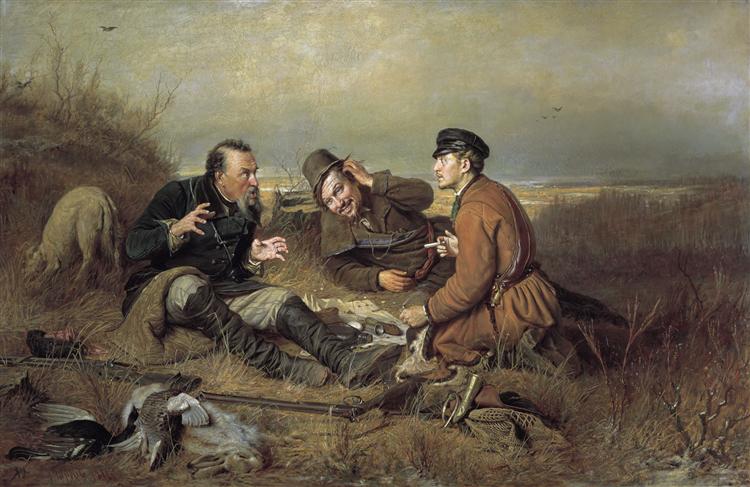Before you is a painting by Vasily Grigorievich Perov “Drawing Teacher”. (State Tretyakov Gallery, Moscow). Written in 1867 on a wooden board by the Windsor and Newton firm, it introduces us to the fate of an artist devoted to the ideals of the beautiful, but not recognized. Elderly, with sparse hair, in a shabby but neat suit, with a dull gaze directed over his glasses to nowhere, he sits as if knocked down by life, holding a drawing lead in his hand. Below, near the armchair (with what simplicity, it is characterized by a few light strokes!), A folder with drawings, a battered cylinder. Behind the teacher’s back, on a music stand, there are study charts for copying: eyes in three turns, lips.
In this tiny (25 / 20cm) painting, perhaps the most striking thing is its highest compositional complexity. And the point here is not in the proportions of color spots, harmony of lines and contours, which have recently increasingly determined the dignity of painting, but in the fullness of the work with the artist’s restless thought, the pain of his sensitive heart.
The beginning of work on the composition dates back to 1863, when the 29-year-old artist was in Paris, but mentally did not part with his native Russia. The pencil sketch shows the scene in more detail. In the next room indifferent master’s children. On the wall is a crooked romantic landscape. In the whole setting, one can feel a disregard for art. Even the dog shows an unfriendly attitude towards the past minister of the muses. In the process of work, Perov selects the most important, “speaking” elements of the composition from the secondary ones, interfering, and adds dramatic intensity to a modest everyday scene. Perov decides the multifaceted story about the teacher’s sorrowful lot in the most expressive, clever and laconic way – through one figure, subordinating the less significant to the leading plastic and semantic idea.
The painting was done on a two-layer soil: the lower layer is white, the upper one is pinkish-cream. The preparatory drawing was done in gray paint. The underpainting is done in two colors: crimson and yellow. The crimson color is tonally developed. The picture was re-painted already in the frame.
Take another look at the reproduction. Try to analyze this sad fiction novel. Try to transfer the experiences you have received into your daily work. “The art of the past, – said the great Alexander Ivanov, – will always and must influence the artist. Learn to be observant. Learn thoughtful selection of details. Learn to convey a lot in compositional sketches with minimal means. “
Composition based on the painting by Vasily Perov “Drawing Teacher”
In 1867 Vasily Grigorievich Perov took part in the World Exhibition in Paris, where Pavel Tretyakov bought from him the now famous painting “Troika”.
Also this year, several significant works were written on the fate of people at the bottom of the social hierarchy. In particular, a small work “Drawing Teacher” was created in its final version.
This picture was written presumably under the impression of the history of the fate of the artist Pyotr Mikhailovich Shmelkov. A serf by birth, he was lucky enough to get into the newly created Moscow art class, from which the Moscow School of Painting, Sculpture and Architecture would later be organized, where his talent blossomed in all its remarkable splendor. He made brilliant progress, showed great promise. For a beautifully painted painting “Reading the Gospel in a Village Church” (1843), he received the title of “free artist” and from the owner “free”.
This happy course of life is suddenly interrupted by the intrigue of one of the teachers and Shmelkov, in order to survive he is forced to go to the cadet corps as a drawing teacher. This kind of occupation almost completely excluded creative activity. Shmelkov never got out of this misfortune. All his life he conceived a picture and believed that his condition was temporary, and he could continue to work. But it never happened. True, he subsequently created a certain genre from his preparatory sketches, which later could well be called caricature or satirical graphics.
In this field, he, being an extremely talented artist, was very successful. According to art historians, he was even able to leave a significant mark on the history of Russian graphics. But the dream of free creativity never came true.
In Perov’s painting, his figure and facial expression show that this man is in the last stage of despair. When you look at him, the heroes of F.M. Dostoevsky from his novels “Poor People”, “Humiliated and Insulted” and “Netochka Nezvanova”.
Such despair, intensified by sheer poverty and physical exhaustion, that it is impossible to look at him without a nagging feeling. The rich furnishings of the room, stacks of traced tables depicting noses, ears and eyes of plaster originals standing on an easel. An empty chair reserved for a rich student who clearly neglects a poor teacher. A folder with drawings of the teacher himself, casually leaning against the wall behind the chair on which our hero is sitting.
Everything indicates the loss of any hope for the future. This picture, like many works by Vasily Grigorievich Perov, reflects the fate of the “little man” in Russia.
Year of painting: 1867.
Painting dimensions: 25 x 20 cm.
Material: canvas.
Writing technique: oil.
Genre: genre painting.
Style: realism.
Gallery: State Tretyakov Gallery, Moscow, Russia.



